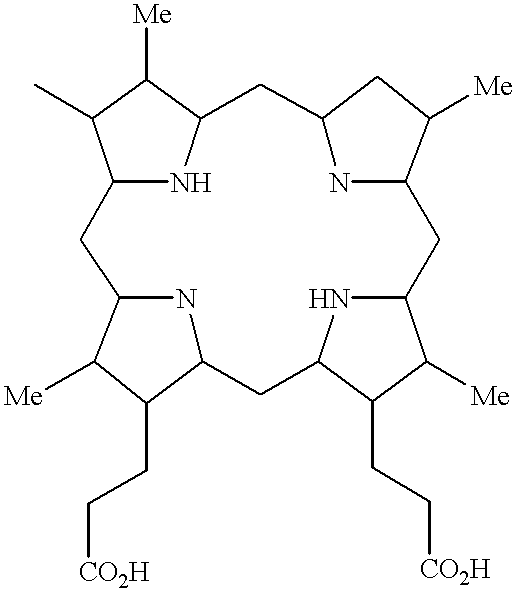Use of photodynamic therapy for prevention of secondary cataracts
a photodynamic therapy and cataract technology, applied in the direction of biocide, heterocyclic compound active ingredients, drug compositions, etc., can solve the problems of difficult to identify all such cells, difficult to reach them on the inside surface of the lens capsule, and poor understanding of the mechanism of the result, so as to shorten the incubation time
- Summary
- Abstract
- Description
- Claims
- Application Information
AI Technical Summary
Benefits of technology
Problems solved by technology
Method used
Image
Examples
example 2
Treatment of HLE Cells with Light Following Incubation with BPD
Cells from Example 1 were exposed to 10 J / cm.sup.2 of red light (690.+-.12.5 nm) delivered with light emitting diodes (LED), immediately after a 10 min. incubation with BPD but subsequent to removal of excess drug. As anticipated, the cell survival was greatly reduced. In the presence of 5% FCS, 400-800 ng BPD / ml followed by red light resulted in 80-100% cell kill. In related experiments conducted in vitro, the sensitivity of HLE cells to BPD and light differed, depending on donors and number of passages in culture (FIG. 4). Cell survival was determined by means of a colorimetric assay, MTT, which measures both the cells metabolic state and proliferation, and thus reflects both the cytotoxic and cytostatic effects. See, Mossman, "Rapid Colorimetric Assay for Cellular Growth and Survival: Application to Proliferation and Cytotoxicity Assays," Journal of Immunological Methods 65:55-63 (1983). Therefore, it was of interest ...
example 3
Treatment of HLE Cells with BPD in a Viscous Solution
As noted above, optimally, in a clinical situation BPD will be delivered in a viscous solution. At present hydroxypropylmethyl cellulose (HPMC; Hymecel.RTM.) or sodium hyaluronate (SH; Amvisc, Ophthalin, Biolon) are appropriate reagents for this purpose and are known to those skilled in the relevant art. Therefore, the photosensitization of HLE cells with BPD delivered in viscous solution was evaluated in other vehicles. Due to its high viscosity, only 25% of Amvisc sodium hyaluronate in a balanced salt solution (BSS, as used in surgery) was tested in an HLE culture system and compared to the 5% FCS in culture medium of Example 2. Data showed that 10 min. incubation of HLE cells with BPD in either of the solutions, followed by 10 J / cm.sup.2 of red light, caused a similar cell kill (FIG. 8). This indicates that BPD effectively can be delivered to cells when in viscous solution.
The containment of BPD in the lens capsule and preventi...
example 4
Treatment of Vero Cells with BPD in a Viscous Solution
Due to difficulties in obtaining sufficient number of HLE cells for testing, some experiments were carried out using Vero cells as a model. The cells were grown on cover slips and treated with BPD in 100% viscous solution (Hymecel, Amvisc and Ophthalin). One minute incubation was used throughout, but light doses and BPD concentrations were varied. BPD was tested at 5-30 .mu.g / ml using light doses of 1, 5 and 10 J / cm.sup.2. Cell survival was determined by fluorescence, using a Cytoprobe Assay Kit (PerSeptive Bio Science; ethidium homodimer, and calcein-AM). Results indicating killing of HLE cells are presented in photographs (FIG. 10.)
PUM
| Property | Measurement | Unit |
|---|---|---|
| concentration | aaaaa | aaaaa |
| wavelength range | aaaaa | aaaaa |
| time | aaaaa | aaaaa |
Abstract
Description
Claims
Application Information
 Login to View More
Login to View More - R&D
- Intellectual Property
- Life Sciences
- Materials
- Tech Scout
- Unparalleled Data Quality
- Higher Quality Content
- 60% Fewer Hallucinations
Browse by: Latest US Patents, China's latest patents, Technical Efficacy Thesaurus, Application Domain, Technology Topic, Popular Technical Reports.
© 2025 PatSnap. All rights reserved.Legal|Privacy policy|Modern Slavery Act Transparency Statement|Sitemap|About US| Contact US: help@patsnap.com



